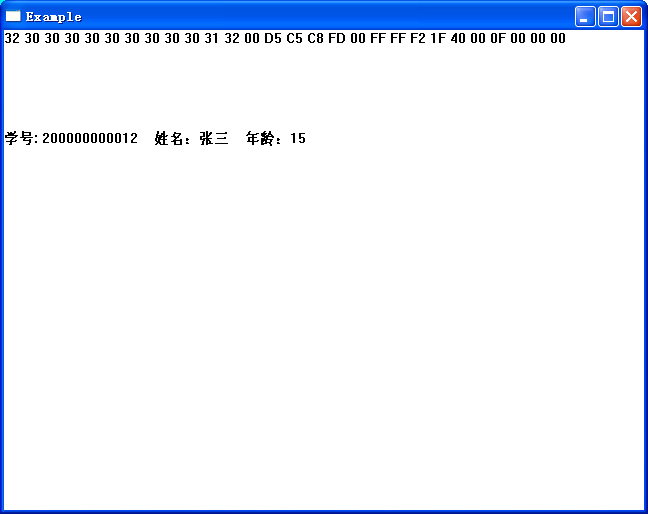【教程】Win32 WNDCLASS窗口类中的额外空间cbClsExtra和cbWndExtra的用法
先来讲讲wc.cbWndExtra这个成员,这个成员指定了系统为每个窗口分配多少字节的额外空间。创建窗口后,如果想要使用这段额外空间,可以使用以下六个函数之一:
GetWindowWord(hWnd, n) // 从第n个字节开始,读取两个字节
GetWindowLong(hWnd, n) // 从第n个字节开始,读取四个字节
GetWindowLongPtr(hWnd, n) // 从第n个字节开始读取。如果系统是32位,则读取4个字节;如果系统是64位,则读取8个字节。(这个一般用来读取指针变量)
SetWindowWord(hWnd, n, value)
SetWindowLong(hWnd, n, value)
SetWindowLongPtr(hWnd, n, value)
还有另外6个类似的函数,是以GetClass或SetClass开头的,那些函数是用来操作wc.cbClsExtra为窗口类分配的空间的,但是传入的参数仍然是hWnd,而非窗口类的名称或指针,也就是根据hWnd来确定是哪一个窗口类。
例如,让wc.cbWndExtra=3,也就是为每个窗口分配3个字节的额外空间。注册窗口类后创建窗口,然后执行:
char str[100];
int a, b;
SetWindowWord(hWnd, 0, 2016); // 语句1
a = GetWindowWord(hWnd, 0); // 语句2
b = GetWindowWord(hWnd, 1); // 语句3
sprintf_s(str, "a=%d, b=%d", a,b);
MessageBoxA(hWnd, str, "额外空间",MB_ICONINFORMATION);
运行程序,可以看到a的值为2016,b的值为7。
创建窗口时分配的3个字节,初始值都是0:
[00000000][00000000][00000000]
语句1把第0个字节和第1个字节分别设为了2016的低八位和高八位,因为2016对应的二进制数是[00000111][11100000],所以这3个字节变成了:
[11100000][00000111][00000000]
语句2的作用是从第0个字节开始,读取两个字节,也就是读取第0和第1个字节,然后赋给变量a,刚好就是2016。
语句3是从第1个字节开始读两个字节赋给b,所以就把第1个字节赋给b的低位,第2个字节赋给b的高位。
b = [00000000][00000111] = 7
如果执行GetWindowWord(hWnd, 2)会怎么样呢?这条语句的作用是同时读取第2个字节和第3个字节,但是因为根本就没有第3个字节,所以这个函数会执行失败,返回0。也就是说,只要读取时有一个字节不存在,那么整个函数就会读取失败。
因此,cbClsExtra和cbWndExtra都只能设置为0或者大于等于2的数,如果设置为1,那么即便是分配了空间也无法使用。
根据这一点,我们就可以编写在额外空间中读写数据块的函数,然后把字符串或者一个结构体变量放入这段额外空间中。
下面的示例程序将一个struct student结构体写入了这段额外空间中。为了确保函数读取最后一个字节时不会出错,设置空间分配大小时使用了EXTRA_BYTES宏将奇数化为偶数。
#include
#include
#include
struct student
{
char id[13];
char name[10];
int age;
};
char *hex = "0123456789ABCDEF";
// 奇数化为偶数
#define EXTRA_BYTES(n) (((n + 1) >> 1) << 1)
// 写入字符串。end为BOOL类型,表示是否写入字符串最后的'\0'
#define extra_puts(hWnd, dest, str, end) extra_write(hWnd, dest, str, strlen(str) + end)
// 获取分配的额外空间大小
#define extra_size(hWnd) GetClassLong(hWnd, GCL_CBWNDEXTRA)
// 读取字符,src为额外空间的第几字节
char extra_getc(HWND hWnd, int src)
{
WORD word;
if (src % 2 == 0)
{
word = GetWindowWord(hWnd, src);
return word & 0xff;
}
else
{
word = GetWindowWord(hWnd, src - 1);
return word >> 8;
}
}
// 读取\0结束的字符串
void extra_gets(HWND hWnd, int src, void *buffer)
{
int i;
char ch;
WORD value;
for (i = -(src % 2); ; i += 2)
{
value = GetWindowWord(hWnd, src + i);
if (i != -1)
{
ch = *(((BYTE *)buffer) + i) = value & 0xff;
if (ch == '\0')
break;
}
ch = *(((BYTE *)buffer) + i + 1) = value >> 8;
if (ch == '\0')
break;
}
}
// 写入一个字符
void extra_putc(HWND hWnd, int src, char ch)
{
WORD word;
if (src % 2 == 0)
{
word = GetWindowWord(hWnd, src);
SetWindowWord(hWnd, src, (word & 0xff00) + ch);
}
else
{
word = GetWindowWord(hWnd, src - 1);
SetWindowWord(hWnd, src - 1, (word & 0x00ff) + (ch << 8));
}
}
// 读取数据块(例如结构体)
void extra_read(HWND hWnd, int src, void *buffer, int n)
{
int i;
WORD value;
for (i = -(src % 2); i < n; i += 2)
{
// dest+i始终为偶数
value = GetWindowWord(hWnd, src + i);
if (i != -1)
*(((BYTE *)buffer) + i) = value & 0xff;
if (i + 1 != n)
*(((BYTE *)buffer) + i + 1) = value >> 8;
}
}
// 写入数据块
void extra_write(HWND hWnd, int dest, void *data, int n)
{
int i;
WORD value;
for (i = -(dest % 2); i < n; i += 2)
{
// dest+i始终为偶数
if (i == -1)
value = GetWindowWord(hWnd, dest - 1) & 0xff; // 读取前一个字节
else
value = *(((BYTE *)data) + i);
if (i + 1 == n)
value += GetWindowWord(hWnd, dest + i) & 0xff00; // 读取后一个字节
else
value += *(((BYTE *)data) + i + 1) << 8;
SetWindowWord(hWnd, dest + i, value);
}
}
LRESULT CALLBACK WndProc(HWND hWnd, UINT uMsg, WPARAM wParam, LPARAM lParam)
{
// 这里的hWnd的值和主函数里的hWnd是完全相同的
char *str, *pStr;
char str2[100];
int size, i, value;
HDC hdc;
PAINTSTRUCT ps;
RECT rect;
struct student stu;
switch (uMsg)
{
case WM_DESTROY:
PostQuitMessage(0);
break;
case WM_PAINT:
hdc = BeginPaint(hWnd, &ps);
// 输出全部额外空间的内存情况
size = extra_size(hWnd);
pStr = str = new char[size * 4];
for (i = 0; i < size; i += 2)
{
value = GetWindowWord(hWnd, i);
*pStr++ = hex[(value >> 4) & 0x0f];
*pStr++ = hex[value & 0x0f];
*pStr++ = ' ';
*pStr++ = hex[(value >> 12) & 0x0f];
*pStr++ = hex[(value >> 8) & 0x0f];
*pStr++ = ' ';
}
*pStr = '\0';
GetClientRect(hWnd, &rect);
DrawTextA(hdc, str, strlen(str), &rect, DT_WORDBREAK);
delete[] str;
// 输出结构体的内容
extra_read(hWnd, 0, &stu, sizeof(struct student));
sprintf_s(str2, sizeof(str2), "学号: %s 姓名:%s 年龄:%d", stu.id, stu.name, stu.age);
TextOutA(hdc, 0, 100, str2, strlen(str2));
EndPaint(hWnd, &ps);
break;
default:
return DefWindowProc(hWnd, uMsg, wParam, lParam);
}
return FALSE;
}
int WINAPI _tWinMain(HINSTANCE hInstance, HINSTANCE hPrevInstance, LPTSTR lpCmdLine, int nCmdShow)
{
WNDCLASS wc;
wc.cbClsExtra = 0;
wc.cbWndExtra = EXTRA_BYTES(sizeof(struct student)); // 确保分配的空间为偶数
wc.hbrBackground = (HBRUSH)(COLOR_WINDOW + 1);
wc.hCursor = LoadCursor(NULL, IDC_ARROW);
wc.hIcon = LoadIcon(NULL, IDI_APPLICATION);
wc.hInstance = hInstance;
wc.lpfnWndProc = WndProc;
wc.lpszClassName = TEXT("Example Window");
wc.lpszMenuName = NULL;
wc.style = CS_HREDRAW | CS_VREDRAW;
RegisterClass(&wc);
RECT rect;
SetRect(&rect, 0, 0, 640, 480);
AdjustWindowRect(&rect, WS_OVERLAPPEDWINDOW, FALSE);
HWND hWnd = CreateWindow(wc.lpszClassName, TEXT("Example"), WS_OVERLAPPEDWINDOW, CW_USEDEFAULT, 0, rect.right - rect.left, rect.bottom - rect.top, NULL, NULL, hInstance, NULL);
if (!hWnd)
return 1;
ShowWindow(hWnd, nCmdShow);
struct student stu;
strcpy_s(stu.id, "200000000012");
strcpy_s(stu.name, "张三");
stu.age = 15;
extra_write(hWnd, 0, &stu, sizeof(struct student));
// 一定要在额外空间写入数据后再刷新窗口,不然窗口显示时只能看到一串0
// UpdateWindow立即执行WM_PAINT,执行完了函数才返回
UpdateWindow(hWnd);
MSG msg;
while (GetMessage(&msg, NULL, 0, 0))
{
TranslateMessage(&msg);
DispatchMessage(&msg);
}
return msg.wParam;
}
